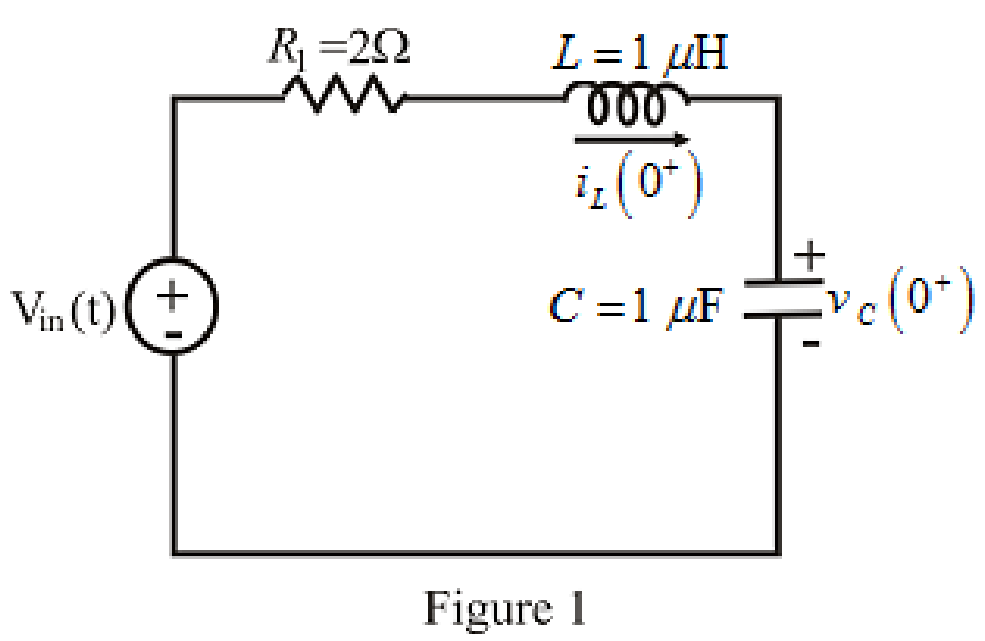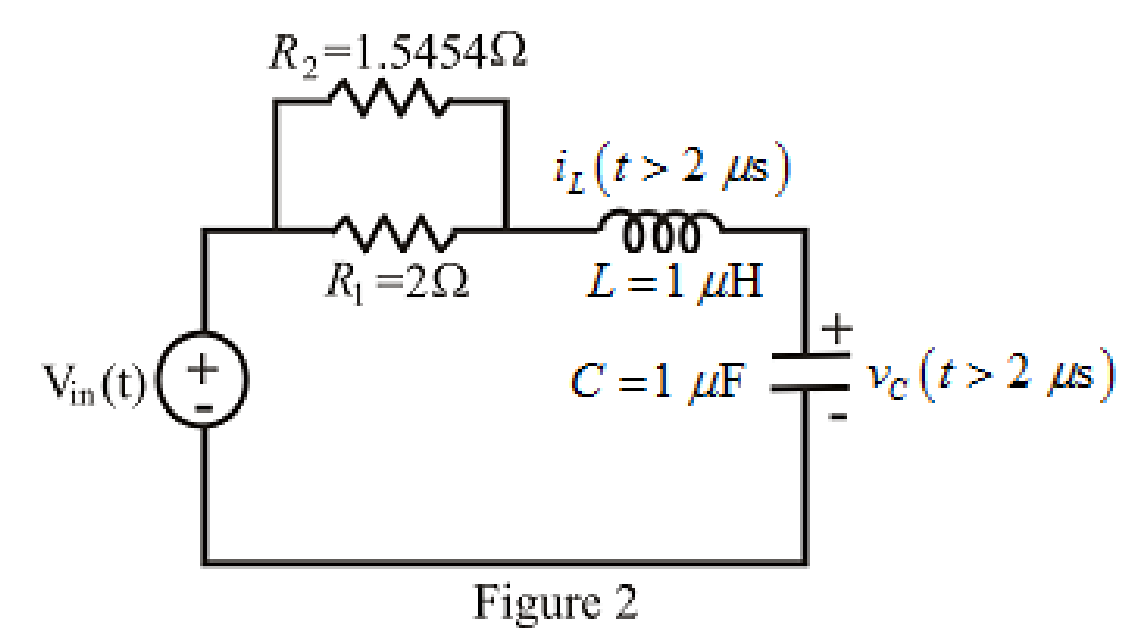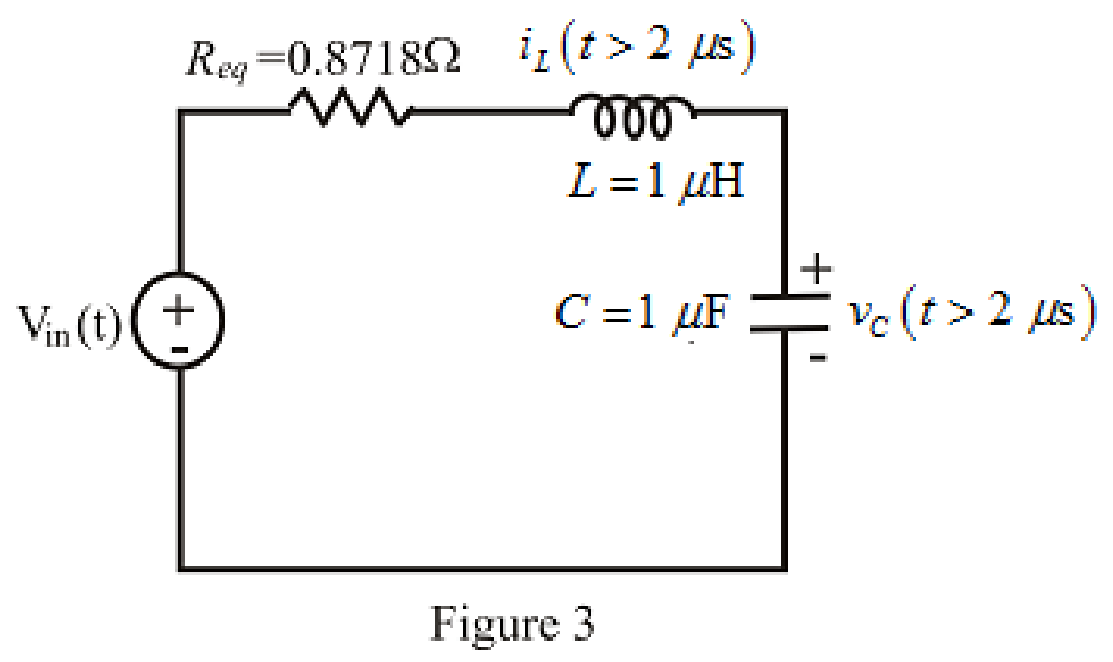
Determine expressions for vC(t) and iL(t) in Fig. 9.59 for the time windows (a) 0 < t <2 μs and (b) t > 2 μs.

FIGURE 9.59
(a)
Determine expressions for
Answer to Problem 62E
The expressions for
Explanation of Solution
Given Data:
The range of the time is
Formula used:
The expression for the exponential damping coefficient or the neper frequency for series
Here,
The expression for the resonant frequency for series
Here,
The expression for complete natural response for source free series
Here,
The expression for the critically damped natural response of the series
Here,
Calculation:
The unit-step forcing function as a function of time which is zero for all values of its argument less than zero and which is unity for all positive values of its argument.
Here,
So, at
Since the series
The capacitor does not allow sudden change in the voltage and the inductor does not allow sudden change in the current.
So,
And,
Therefore, the voltage across the capacitor at
At
The redrawn circuit diagram is given in Figure 1 at

Refer to the redrawn Figure 1:
Substitute
Substitute
Here, the resonant frequency is equal to the exponential damping coefficient.
Therefore, the response of the circuit is critically damped.
At
Therefore, the value of forced response
Substitute
Substitute
The voltage across the capacitor at
Substitute
Rearrange for
The expression for the current flowing through
So, the current flowing through
The expression for the current flowing through the
Substitute
Rearrange for
Substitute
The current flowing through
Substitute
Substitute
Rearrange for
Substitute
The expression for the current flowing through the
Substitute
Substitute
Conclusion:
Thus, the expressions for
(b)
Determine expressions for
Answer to Problem 62E
The expressions for
Explanation of Solution
Formula used:
The expression for the damped natural frequency in series
Here,
The expression for natural response for series
Here,
Calculation:
The redrawn circuit diagram is given in Figure 2 at

Refer to the redrawn Figure 2:
The initial condition of the voltage across the
Substitute
So, the initial condition of the voltage across the
Substitute
So, the initial condition ofthe current through the
At
The expression for the equivalent resistor when resistors are connected in parallel is as follows:
Here,
So, form equation (15),
Rearrange for
The redrawn circuit diagram is given in Figure 3.

Refer to the redrawn Figure 3:
Substitute
Substitute
Here, the resonant frequency is greater than the exponential damping coefficient.
Therefore, the response of the circuit is under-damped damped.
Substitute
At
Therefore, the value of forced response
Substitute
Apply time shift in equation (18).
Substitute
The initial condition of the voltage across the
Substitute
Rearrange for
The expression for the current flowing through
So, the current flowing through
The expression for the current flowing through the
Here,
Rearrange for
Substitute
Substitute
Substitute
Substitute
Rearrange for
Substitute
Substitute
Substitute
Conclusion:
Thus, the expressions for
Want to see more full solutions like this?
Chapter 9 Solutions
Loose Leaf for Engineering Circuit Analysis Format: Loose-leaf
- The characteristic equation of a system is given by S5+2S4+S3+2S2+S+5=0 Determine (i) Stability of the system (ii) Number of roots on the right side of 's' - Plane (iii) Number of roots on the left side of 's' - Planearrow_forwardA circuit is constructed with an AC generator, a resistor, capacitor and inductor as shown. The generator voltage varies in time as ε =Va - Vb = εmsinωt, where εm = 120 V and ω = 726 radians/second. The values for the remaining circuit components are: R = 62 Ω, L = 95.6 mH, and C = 13.8μF. 4) What is t1, the first time after t = 0 when the voltage across the inductor is zero? 6) What is VC = Vd - Va, the voltage across the capacitor, at time t = 0? Note that VC is a signed number.arrow_forwardcan you solve this quickly? With reference to the source voltage, show the values of v, i, vr, vc in the time plane, the phasor plane and the complex plane.arrow_forward
- A series LR circuit has a variable inductor with theinductance L(t) is defined by intervals.Find the current i(t) if the resistance is 0.2 ohms, the voltageapplied is E(t) = 4 volts; knowing that i(0) = 0.arrow_forwardSet up a system of first-order differential equations for theindicated currents I1 and I2 in the electrical circuit ofFig. 4.1.14, which shows an inductor, two resistors, anda generator which supplies an alternating voltage drop ofE(t) = 100 sin 60t V in the direction of the current I1.arrow_forwardCalculate the current in an RLC circuit with resistances R=11 ohms, L=0.1 H, and C=10^-2 F that is linked to the source V(t)= 10sin 377t. Assume that the capacitor charge and current are both zero at time t=0.arrow_forward
- A 200 Ω resistor, 0.900 H inductor, and 6.00 µF capacitor are connected in series across a voltage source that has voltage amplitude 30.0 V and an angular frequency of 250 rad/s. (a) What are v, vR, vL, and vC at t = 20.0 ms? Compare vR + vL + vC to v at this instant. (b) What are VR, VL, and VC? Compare V to VR + VL + VC. Explain why these two quantities are not equal.arrow_forwarda series r-c circuit takes a current whose equation is i=0.85sin(754t+pi/4) when connected to a source of emf having the equation e=340sin754t. calculate the capacitance of the capacitor, circuit power factor, and power.arrow_forwardA resistor of 100 Ω, a coil of 4.50 μH, and a capacitor of 220 pF are in parallel. What is the admittance vector at 6.50 MHz? Provide illustration of the circuit.arrow_forward
- In the circuit shown , the dc current source is replaced with a sinusoidal source that delivers a current of 1.2cost A. The circuit components are R=1 Ω, C=625 mF, and L=1.6 H. Find the numerical expression for V(s).arrow_forwardIf the roots of the characteristic equation are -3,0 then the system is _________________________. Marginally stable Conditionally stable Stable Unstablearrow_forwardH = 3RM2cos(9ft) where f = frequency, t = time, and the remaining variables are either proportionality constants or material constants. What is the maximum value H could have (algebraic answer)arrow_forward
 Introductory Circuit Analysis (13th Edition)Electrical EngineeringISBN:9780133923605Author:Robert L. BoylestadPublisher:PEARSON
Introductory Circuit Analysis (13th Edition)Electrical EngineeringISBN:9780133923605Author:Robert L. BoylestadPublisher:PEARSON Delmar's Standard Textbook Of ElectricityElectrical EngineeringISBN:9781337900348Author:Stephen L. HermanPublisher:Cengage Learning
Delmar's Standard Textbook Of ElectricityElectrical EngineeringISBN:9781337900348Author:Stephen L. HermanPublisher:Cengage Learning Programmable Logic ControllersElectrical EngineeringISBN:9780073373843Author:Frank D. PetruzellaPublisher:McGraw-Hill Education
Programmable Logic ControllersElectrical EngineeringISBN:9780073373843Author:Frank D. PetruzellaPublisher:McGraw-Hill Education Fundamentals of Electric CircuitsElectrical EngineeringISBN:9780078028229Author:Charles K Alexander, Matthew SadikuPublisher:McGraw-Hill Education
Fundamentals of Electric CircuitsElectrical EngineeringISBN:9780078028229Author:Charles K Alexander, Matthew SadikuPublisher:McGraw-Hill Education Electric Circuits. (11th Edition)Electrical EngineeringISBN:9780134746968Author:James W. Nilsson, Susan RiedelPublisher:PEARSON
Electric Circuits. (11th Edition)Electrical EngineeringISBN:9780134746968Author:James W. Nilsson, Susan RiedelPublisher:PEARSON Engineering ElectromagneticsElectrical EngineeringISBN:9780078028151Author:Hayt, William H. (william Hart), Jr, BUCK, John A.Publisher:Mcgraw-hill Education,
Engineering ElectromagneticsElectrical EngineeringISBN:9780078028151Author:Hayt, William H. (william Hart), Jr, BUCK, John A.Publisher:Mcgraw-hill Education,





